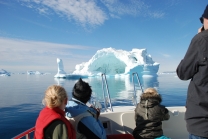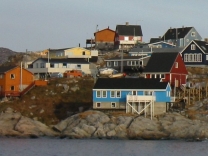
Jakobshavn Glacier
Jakobshavn Glacier Danish: Jakobshavn Isbræ, also known as Ilulissat Glacier Greenlandic: Sermeq Kujalleq is a large outlet glacier in West Greenland. It is located near the Greenlandic town of Ilulissat (colonial name in Danish: Jakobshavn) and ends at the sea in the Ilulissat Icefjord.
Jakobshavn Glacier drains 6.5% of the Greenland ice sheet and produces around 10% of all Greenland icebergs. Some 35 billion tonnes of icebergs calve off and pass out of the fjord every year. Icebergs breaking from the glacier are often so large (up to 1 km in height) that they are too tall to float down the fjord and lie stuck on the bottom of its shallower areas, sometimes for years, until they are broken up by the force of the glacier and icebergs further up the fjord. Studied for over 250 years, the Jakobshavn Glacier has helped develop modern understanding of climate change and icecap glaciology.
Ilulissat Icefjord (Greenlandic: Ilulissat Kangerlua) was declared a UNESCO World Heritage Site in 2004.
Name
Jakobshavn has been a name used for this glacier in scientific literature since 1853 when Danish geologist Hinrich Johannes Rink referred to it as Jakobshavn Isstrøm (Danish for Jakobshavn Ice Stream). It is sometimes referred to in the international scientific literature (by glaciologists) as Jakobshavn Isbræ glacier. Isbræ is Danish for glacier. It is also commonly known by the anglicised version, Jakobshavn Glacier.
The local name for this glacier is Sermeq Kujalleq, where "sermeq" is Greenlandic for 'glacier' and "kujalleq" means 'southern'. It lies south of the town Ilulissat (colonial name Jakobshavn). UNESCO's World Heritage Site website uses this name, in connection with mention of the Ilulissat Icefjord world heritage site, which includes the downstream end of the glacier.
There is evidence that people have inhabited the area around the glacier for up to 4000 years. The recently abandoned settlement of Sermermiut (which means 'place of the glacier people') lies just to the north of the glacier, much nearer than...











